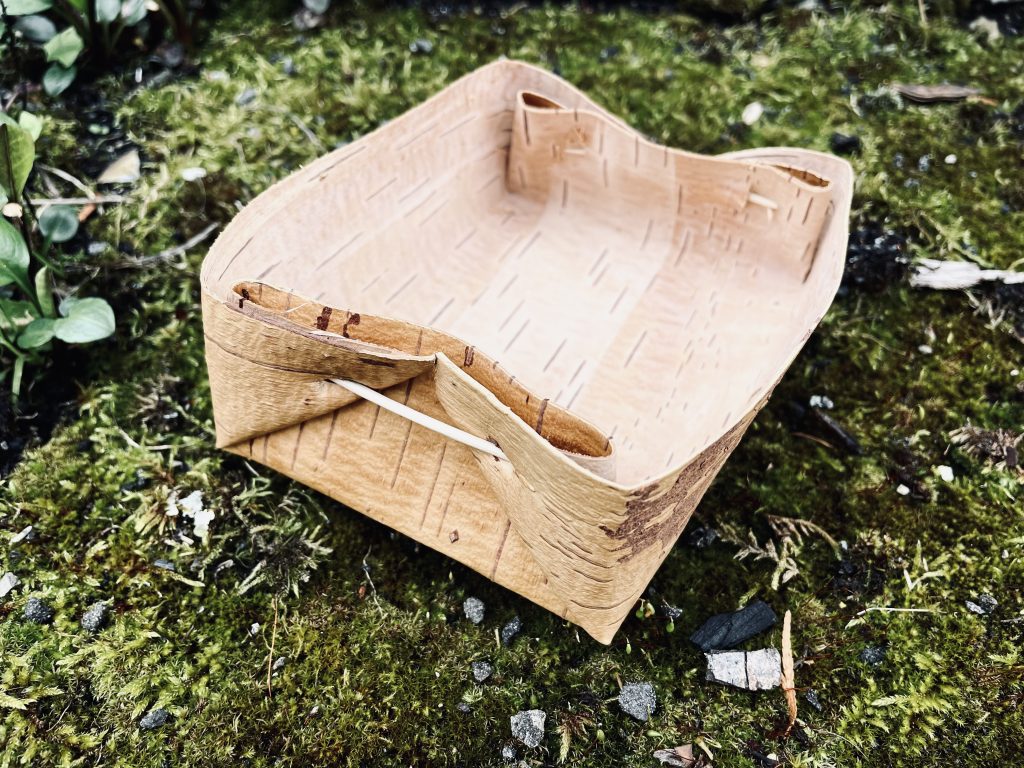By Antje Wilton, Free University Berlin
One of the craft activities we will offer during the construction of our Mesolithic hut is making a simple container from birch bark. Bark was a common material in the Mesolithic – in fact, throughout the stone age and beyond, as it is extremely versatile. In the archaeological record, we find mats and containers of different shapes and sizes preserved primarily in waterlogged ground, where the absence of oxygen helped to preserve otherwise degradable objects. Birch bark was also necessary for the production of birch tar, a sticky substance used like glue, for instance to attach projectiles to shafts for making arrows or spears.
Our container is modeled on a find from Friesack (Brandenburg), an important Mesolithic site on the North Geman Plain. At Friesack, an extraordinary number of finds made of organic materials such as wood, bark and bast were preserved (Gramsch 2000). Detailed information on the site can be found in the publications by Bernhard Gramsch, one of which introduces the birch bark container we are interested in for our project. The following discussion is based on that publication (Gramsch 1993).
One of the features discovered at the site was a former waterhole, the remains of which were indicated by soil marks. At the bottom of the pit, archaeologists found an almost complete container made from birch bark – radiocarbon dated to about 8950+/-100 BP (OxA-600), (see figure 1).

The container was perfect in the way it was made: a piece of birch bark, measuring about 32×18 cm, was seamlessly folded to make the container watertight, a method well documented since the Mesolithic until the present day (Piezonka 2023). The container was deformed by the pressure of the accumulated soil in the waterhole, but its original dimensions were given as 16x6cm. The height cannot be determined exactly because of damage to the container’s rim, but is thought to be about 6cm. The production process can be reconstructed as follows: the shorter sides were folded over by about 2cm. The shorter sides were folded upwards first, then the longer sides, which created diagonal folds in the corners. Those were folded across the shorter sides and then pierced with two holes. Presumably, either wooden sticks or possibly some sort of string were then threaded through the holes to secure the folds. However, they do not survive in the archaeological record. Figure 2 shows a model illustrating the technique.

We do not know for sure what the container was used for – its position at the bottom of the waterhole makes it very likely that it was used to collect water from the hole and got lost or was thrown away after use, or maybe that it was deposited there intentionally for a symbolic purpose. Either way, such easily made containers must have been widely used in many different contexts – we will explore both the making as well as possible applications together with our visitors!
References:
Gramsch, Bernhard (1993): Ein mesolithischer Birkenrindenbehälter von Friesack. Veröffentlichungen des Brandenburgischen Museums für Ur- und Frühgeschichte 27, 7-15.
Gramsch, Bernhard (2000): Friesack: Letzte Jäger und Sammler in Brandenburg. Jahrbuch des Römisch-Germanischen Zentralmuseums Mainz 47, 51-96.
Piezonka, Henny (2023): A view from the northern forests: Container technology of boreal hunter-gatherers. In: Nieuwenhuyse, Olivier P.; Bernbeck, Reinhard & Berghuijs, Koen (eds.): Containers of Change. Ancient container technologies from Eastern to Western Asia. Leiden: Sidestone Press, 155-176.